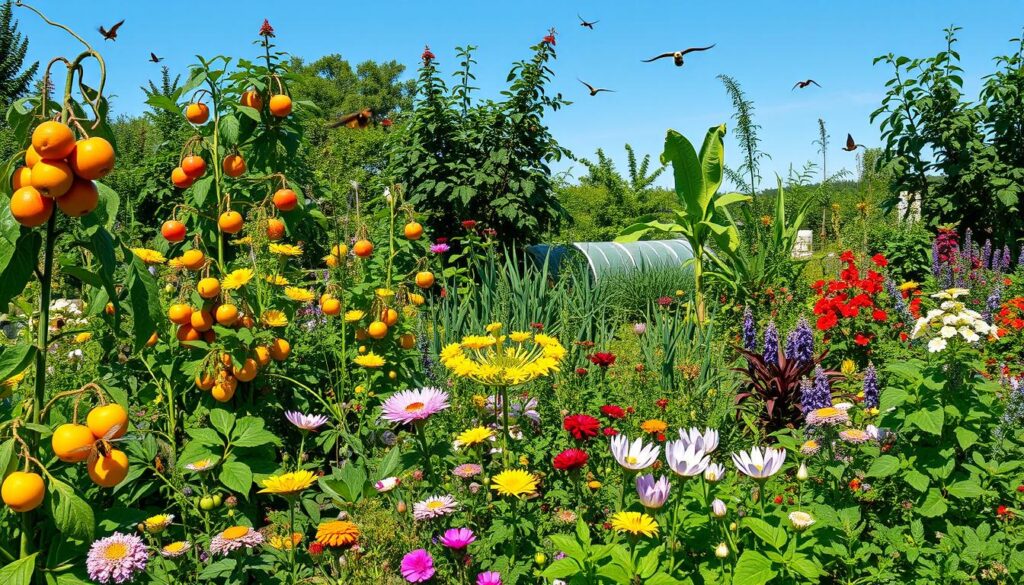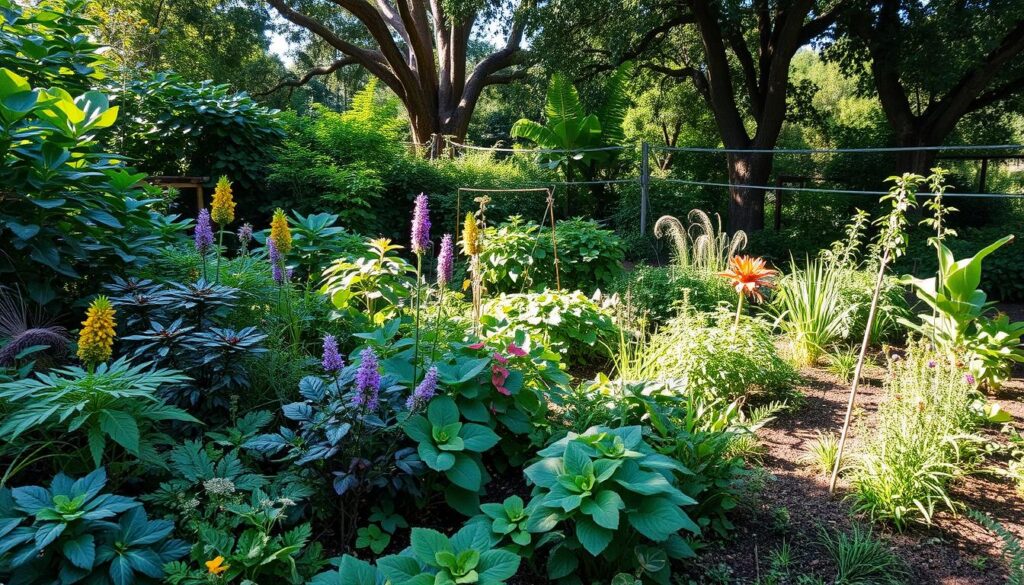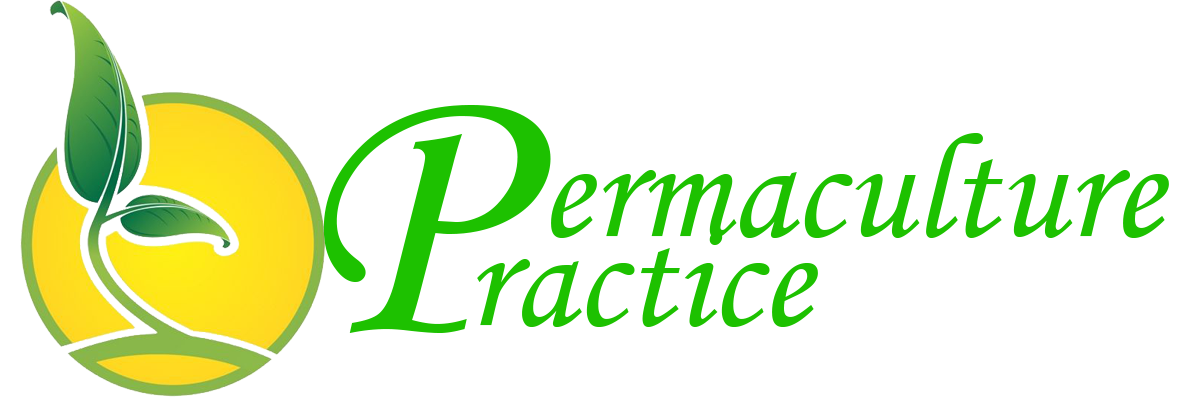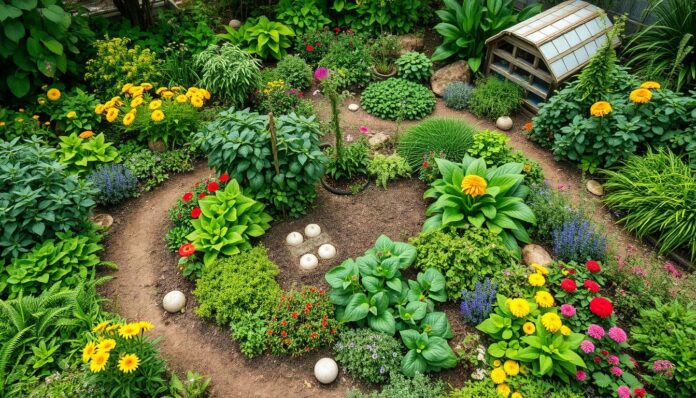The world is moving towards sustainable and regenerative farming. Permaculture is leading the way in using resources wisely. It helps farmers and gardeners lower their environmental impact while boosting crop yields and biodiversity. But how does permaculture make farming more sustainable and efficient?
Permaculture is all about creating sustainable ecosystems like nature. It teaches us to make gardens that need little care and waste less. This approach is good for the planet and makes farming more efficient, attracting those who care about the environment.
Introduction to Permaculture
Permaculture is becoming more popular worldwide. It was started by Bill Mollison and David Holmgren. They wanted to make farming permanent and waste-free.
Permaculture teaches us to use waste as a resource. This way, we can farm without needing lots of fertilizers and pesticides. It’s a greener way to farm.
Key Takeaways
- Permaculture is a holistic approach to agriculture that aims to create sustainable ecosystems.
- Permaculture resource efficiency can be achieved through the adoption of sustainable agriculture practices and environmental stewardship techniques.
- Permaculture principles can help reduce waste, promote biodiversity, and enhance the overall efficiency of farming systems.
- Permaculture is a regenerative approach to agriculture that can help mitigate the effects of climate change.
- By adopting permaculture principles, individuals can create self-sustaining gardens and promote sustainable agriculture practices.
- Permaculture can help reduce pollution levels, minimize the use of tractors, and reduce the presence of toxins in the environment.
Understanding Permaculture Resource Efficiency
Permaculture focuses on using resources wisely. It aims to create systems that work well on their own, needing less outside help. This is done by using eco-friendly farming and regenerative agriculture, which care for the soil, support many species, and use water smartly.
By following these methods, farmers can cut down on waste and save money. They also build stronger, more reliable farms. Regenerative agriculture, for example, works to improve soil health, which can increase by up to 20% over time with good care.
Definition of Resource Efficiency in Permaculture
In permaculture, using resources well means using water, soil, and sunlight to grow lots of different foods. This method brings together many species to make farms stronger and more productive. It also means using less outside help and harming the environment less.
Importance of Resource Efficiency
Resource efficiency is key in permaculture. It helps farmers use natural ways to grow food, avoiding harmful chemicals. This makes food healthier and the farming process better for the planet. It also helps fight climate change and supports more life in nature, making our food system more sustainable.
| Permaculture Principle | Benefits |
|---|---|
| Soil Health | Improved fertility, increased nutrient density in food |
| Biodiversity | Enhanced ecological resilience, reduced pest pressure |
| Water Efficiency | Reduced irrigation needs, improved soil moisture |
Principles of Permaculture Design
Permaculture design focuses on creating systems that work well with nature. It uses organic gardening strategies to make ecosystems that grow lots of food and harm the environment less. Green living practices are key in permaculture, helping us live in a more sustainable way.
Some important principles of permaculture design include:
- Efficient energy planning through zoning and sectoring
- Using biological resources to reduce reliance on fossil fuels
- Promoting diversity through polycultures and guild structures
- Utilizing edge and natural patterns to optimize resource use
The 12 principles of permaculture design highlight the need for sustainable agriculture practices. These principles help create ecosystems that are productive, resilient, and can adapt to changes.

Permaculture design is more than just creating sustainable systems. It’s about living in harmony with nature. By using green living practices and organic gardening strategies, we can help make the future more sustainable. We can create ecosystems that are good for both people and the planet.
| Principle | Description |
|---|---|
| Observe and Interact | Observe and interact with nature to understand its patterns and rhythms |
| Catch and Store Energy | Catch and store energy from the environment to reduce reliance on external resources |
| Obtain a Yield | Obtain a yield from the system to ensure its productivity and sustainability |
Soil Health and Fertility Management
Soil is key in permaculture, acting as a “rechargeable battery” for the ecosystem. Using compost, leaves, and grass clippings can boost soil health. Eco-friendly farming methods, like regenerative agriculture, also help keep soil fertile.
Here are some ways to build healthy soil:
- Adding organic matter like compost and manure to increase soil water retention and nutrient cycling
- Using cover crops to reduce soil erosion and promote microbial diversity
- Implementing crop rotation to improve soil health and yield
Regenerative agriculture solutions, such as no-till farming and agroforestry, also boost soil fertility. These methods reduce erosion, increase organic matter, and support biodiversity.
By using these techniques, farmers can make soil healthier. This reduces the need for chemical fertilizers and supports a healthier ecosystem. It’s good for the environment and makes farming more sustainable and efficient.
| Practice | Benefit |
|---|---|
| Composting | Improves soil water retention and nutrient cycling |
| Cover crops | Reduces soil erosion and promotes microbial diversity |
| Crop rotation | Improves soil health and yield |
Water Management Strategies
Effective water management is key in permaculture. It helps save this vital resource and cuts down on waste. By using sustainable design, we can make the most of water, helping both the planet and people. Freshwater is getting scarcer worldwide, affecting many areas.
Permaculture can make soil hold more water, needing less from outside. On-contour swales help water soak into the soil, keeping it moist. Keyline design uses channels to catch rainwater, and clay-lined basins trap water in dry areas.

- Rainwater harvesting using rain barrels, swales, and ponds
- Greywater recycling systems to reuse water from households
- Efficient irrigation practices, such as drip irrigation and mulching
These methods cut down on water waste, boost crop yields, and support green farming. By using them, we can make a better future and lessen our impact on the environment.
It’s vital to understand water’s flow and cycle in permaculture. By managing water wisely, we can save it, reduce waste, and live greener. This leads to a healthier planet for all.
Energy Efficiency in Permaculture Systems
Permaculture systems aim to get the most out of little, using energy wisely. They use renewable energy like solar and wind to cut down on non-renewable sources. This way, they help the environment and use resources better.
Methods like composting and greywater recycling cut down on waste and energy use. Composting keeps nutrients from being lost. Greywater recycling uses water from sinks and showers for plants. These methods save resources and support sustainable farming.
Renewable Energy Integration
Renewable energy like solar and wind is key in permaculture. Solar power can run irrigation systems. Wind power can make electricity. These methods lower carbon emissions and support green farming.
Reducing Energy Use in Practices
Permaculture uses smart garden design and zoning to save energy. Planting based on sunlight needs helps. Windbreaks save moisture and cut down on watering needs. These practices lower energy use and support green farming.
| Practice | Energy Savings |
|---|---|
| Composting | 30% reduction in waste |
| Greywater Recycling | 40% increase in water availability |
| Solar Energy | 60% reduction in energy costs |
Biodiversity and Its Role in Resource Efficiency
Biodiversity is key in permaculture. It boosts ecosystem services, soil health, and helps with climate control. By using organic gardening strategies, we can increase biodiversity in our gardens. This helps the environment and supports green living practices by cutting down on waste and external inputs.
Studies show permaculture sites have more soil carbon, earthworms, and plant species than control fields. For instance, permaculture sites have 27% more soil carbon, 201% more earthworms, and 457% more plant species. These numbers highlight biodiversity’s positive effects on ecosystem health and resilience.
Benefits of Diverse Plant Species
Diverse plant species are vital for ecosystem balance and biodiversity. Mixing native and non-native plants boosts pollinators, soil quality, and habitat connectivity. This is crucial for ecosystem services like pollination, pest control, and climate regulation.

Creating Habitat for Beneficial Organisms
It’s important to create habitats for beneficial organisms like pollinators and decomposers. By offering a variety of plants, we support a range of beneficial organisms. This is key for regenerative agriculture solutions and green living practices. Using organic gardening strategies helps create a thriving ecosystem that benefits both nature and people.
Waste Management in Permaculture
Effective waste management is key in permaculture. It helps create a self-sufficient and regenerative ecosystem. By using eco-friendly farming methods, people can greatly reduce their environmental impact. Composting is a major strategy here, turning organic waste into nutrient-rich soil.
Sustainable design is crucial for managing waste. It focuses on closing nutrient loops and reducing waste. Techniques like composting and upcycling help individuals rely less on external inputs. This makes ecosystems more resilient.
- Hot composting, which can yield quality compost within 1-3 months
- Cold composting, which typically takes 1-2 years for the organic material to decompose
- Vermicomposting, which can process up to 1/2 of kitchen scraps per week
By using these strategies, people can make their ecosystems more sustainable and regenerative. This also reduces their environmental impact.
| Composting Method | Timeframe | Benefits |
|---|---|---|
| Hot Composting | 1-3 months | Fast decomposition, high-quality compost |
| Cold Composting | 1-2 years | Low maintenance, suitable for large quantities |
| Vermicomposting | 1-2 weeks | High nutrient content, suitable for small spaces |
Minimizing Inputs through Natural Systems
Permaculture uses natural systems to cut down on external inputs. This is key to sustainable agriculture practices. It focuses on green living practices to lessen farming’s environmental footprint. By doing this, farmers use fewer chemical pesticides and fertilizers, making the ecosystem healthier.
Permaculture also employs natural pest control methods. This includes introducing helpful insects or using barriers to guard crops. Plant guilds and companion planting boost biodiversity, soil health, and crop strength. These methods help make farming more efficient and sustainable, fitting permaculture’s resource efficiency principles.
Utilizing Natural Pest Control
Natural pest control is vital in permaculture. It cuts down on chemical pesticide use and supports a balanced ecosystem. By adding beneficial insects or using barriers, farmers protect their crops without harming the environment.

Plant Guilds and Companion Planting
Plant guilds and companion planting boost biodiversity and soil health in permaculture. By planting different species together, farmers create a more resilient and efficient farm. This approach is a core part of sustainable agriculture practices and supports the goal of green living practices.
Community Involvement in Permaculture
Getting the community involved is key to permaculture’s success. By creating local networks and teaching others about green practices, we can share knowledge and resources. This helps make local food systems stronger and supports sustainable design principles.
Models like community-supported agriculture (CSA) have shown great success. They let people buy shares of a farm’s produce, helping farmers and giving consumers fresh, local food. Organic gardening strategies are vital in these models, as they improve soil health and biodiversity.
Building Local Networks
To create local networks, join community events, online forums, and workshops on permaculture and regenerative agriculture solutions. Connecting with others helps share knowledge, resources, and skills. This strengthens our local food systems.
Educating Others
Teaching others about organic gardening strategies and permaculture is crucial. Share your knowledge through workshops, online tutorials, and community events. By promoting green practices, you inspire others to join in and help build a more resilient food system.
| Community Involvement Strategies | Benefits |
|---|---|
| Building local networks | Facilitates knowledge sharing and resource exchange |
| Educating others | Promotes sustainable practices and inspires community involvement |
Implementing Crop Rotation Effectively
Crop rotation is key in permaculture, offering many benefits for soil and farming. By using eco-friendly farming methods like cover cropping, farmers can better absorb water. This is vital since farming uses almost 70% of the world’s freshwater.
Crop rotation boosts soil health, cuts down on erosion, and increases biodiversity. It also raises crop yields, helping farmers deal with climate change. Plus, it helps fight hunger as the world’s population grows.
Some main benefits of crop rotation are:
- Improved soil health and fertility
- Reduced soil erosion and increased biodiversity
- Increased crop yields and productivity
- Reduced need for synthetic fertilizers and pesticides
By using environmental stewardship techniques and sustainable agriculture practices, farmers can protect ecosystems. Legumes and cover crops like rye or oats help. They cut down on synthetic fertilizers and weed killers.
Good crop rotation plans can lower pest problems, improve soil, and boost yields. Farmers adopting these methods help the environment and their own success.
| Crop Rotation Benefits | Description |
|---|---|
| Improved Soil Health | Increased soil fertility and reduced erosion |
| Increased Crop Yields | Improved productivity and reduced crop losses |
| Reduced Environmental Impact | Decreased need for synthetic fertilizers and pesticides |
Climate Adaptation through Efficient Practices
As the world deals with climate change, permaculture resource efficiency is key. It helps communities adapt. By using green living practices, we can lower our carbon footprint. This leads to a more sustainable future.
Permaculture focuses on building resilient systems. These systems can handle climate change impacts. This is crucial for our planet’s health.
Using regenerative agriculture solutions like crop rotation and composting helps. It makes soil better, reduces erosion, and boosts biodiversity. This not only captures carbon but also makes ecosystems stronger.
Also, smart water use is vital. Practices like rainwater harvesting and greywater recycling save water. They also cut down on waste.
- Improved soil fertility and structure
- Increased biodiversity and ecosystem services
- Enhanced water retention and efficient use
- Reduced greenhouse gas emissions and carbon footprint
By embracing these green living practices and regenerative agriculture solutions, we can be more self-sufficient. We rely less on outside resources. This is crucial for a sustainable future.
Tools and Technologies for Resource Efficiency
Using sustainable design in permaculture means we need the right tools and tech. Eco-friendly farming methods like precision agriculture and renewable energy help cut waste. They also help us take better care of the environment.
For small farms, GIS mapping and drone technology are game-changers. They help farmers map and watch their land. This makes farming more efficient and helps prevent problems.
Innovative Tools for Small-Scale Farming
- Precision agriculture equipment for efficient irrigation and fertilization
- Rainwater harvesting systems to collect and store rainwater for non-potable uses
- Solar panels and wind turbines for renewable energy generation
Technology for Monitoring and Management
Technology is key for keeping an eye on permaculture systems. Sensors, drones, and satellite images help track soil and crop health. This lets farmers make smart choices and improve their farming.
| Tool/Technology | Description | Benefits |
|---|---|---|
| GIS mapping | Geographic information system mapping for land mapping and monitoring | Optimizes resource use, predicts and prevents problems |
| Drone technology | Aerial mapping and monitoring using drones | Improves crop health monitoring, reduces labor costs |
| Sensors | Soil moisture, temperature, and crop health sensors | Enables data-driven decision-making, optimizes resource use |
Case Studies of Successful Permaculture Systems
Permaculture systems are thriving worldwide. They show how organic gardening strategies and green living practices work. These systems prove that regenerative agriculture solutions can lead to sustainable farming.
The Bangalore model farm is a great example. It boosts yield and profit with permaculture. The urban permaculture project in cities uses vertical gardens to make the most of small spaces.
Examples of High-Efficiency Models
- Zaytuna Farm, a 66-acre permaculture education center in Australia
- Village Homes, a 70-acre subdivision in California with 23 acres dedicated to agricultural land and community areas
- The Greening the Desert Project, a community-led initiative to regenerate local ecosystems in arid climates
These examples prove permaculture’s power. They show how to use organic gardening strategies, green living practices, and regenerative agriculture solutions. By learning from them, we can make farming more sustainable and efficient.
Lessons Learned from Field Trials
| Project | Location | Key Features |
|---|---|---|
| Bangalore Model Farm | India | Rainwater harvesting, greywater recycling, and crop rotation |
| Urban Permaculture Project | USA | Vertical gardening, community involvement, and education |
| Zaytuna Farm | Australia | Permaculture education, agroforestry, and biodiversity conservation |
By examining these case studies, we can improve our permaculture systems. We can apply what we learn to make farming more sustainable and efficient. This supports organic gardening strategies, green living practices, and regenerative agriculture solutions.
Policy and Permaculture Resource Efficiency
Government policies greatly influence the use of permaculture. Sustainable agriculture practices can be helped or blocked by these policies. They often decide how many resources farmers get and what incentives they have.
The effects of policies on permaculture are wide-ranging. They impact the environment and the financial success of farming in a green way.
It’s key to push for environmental stewardship techniques and eco-friendly farming methods in permaculture. We need to make policymakers, farmers, and buyers see the good side of permaculture. This includes better soil, more wildlife, and less harm to nature.
Supporting policies that back green farming helps permaculture grow. This makes our food system more sustainable.
- Providing incentives for sustainable practices
- Regulating external inputs to reduce environmental harm
- Protecting biodiversity and promoting ecosystem services
By working on these policy areas, we can make a space for permaculture andsustainable agriculture practices to flourish. This helps make our food system greener.
Future Trends in Permaculture Resource Efficiency
The future of permaculture looks bright, with a focus on sustainability and regrowth. New practices and tech are set to boost permaculture’s efficiency and strength. Permaculture resource efficiency will be key in solving big issues like resource loss and climate change.
Experts like Andrew Millison and Darren Doherty are leading the way in permaculture. They’re pushing the limits of sustainable design, using the latest in precision farming and renewable energy. As regenerative agriculture solutions spread, permaculture will help communities live greener and more self-sufficient lives.
Research is vital in making permaculture better. Events like the Permaculture Water Summit at Oregon State University focus on new water management ideas. Experts like Natalie Topa are also working hard to restore ecosystems, showing permaculture’s wide impact.
Permaculture is a beacon of hope for a sustainable future. It offers a complete and strong way to live sustainably. By following these trends, permaculture can help create a better, more balanced world for all.

